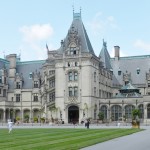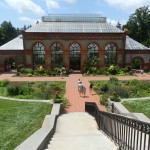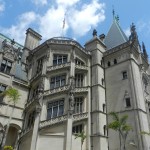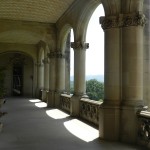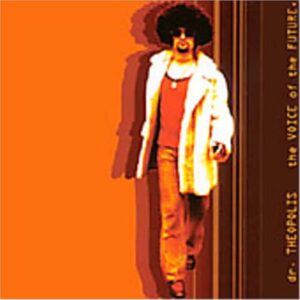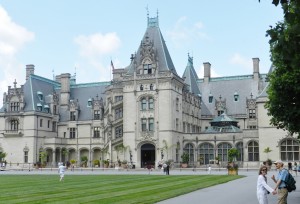
It’s hard to appreciate the size of Biltmore until you are there. The parking lots are beyond the extended front lawn, which is called the Esplanade, and visitors can either take a shuttle from the lots or walk up the Esplanade to the house. We chose the latter, and we found the distance to be further than it looked because the house was so large as to distort visual perspective. The house just kept getting bigger, and it seemed to take forever for us to arrive at the door.
The weather was getting East Coast hot, with temperature and humidity in the nineties, so we walked around the grounds first before taking the house tour in the afternoon. The conservatory was large enough by itself to house a good-sized McMansion. Most of it housed exotic palms, ferns, and other greenery. There were fewer orchids in bloom than I’d anticipated, though one in particular caught my eye for its unusual shape and screamingly bright shade of pink. Outside, we wandered through grounds originally designed by Frederick Law Olmstead, creator of New York’s Central Park, until we were hot and footsore enough to return to the house for lunch at the Stable Cafe, in what had originally been the horse stables. The restaurant, with the stalls converted to booths, boasted a locally sourced menu. I enjoyed the bison burger.
The house tour went through about 40 of the 250 rooms, which was more than enough to give a thorough introduction to the pinnacle of upper-class life in turn-of-the-20th-century America. Unfortunately, they didn’t allow pictures inside, probably to protect the artwork from camera flashes but possibly also to induce visitors to buy the official souvenir book (successfully, in my case). The décor was florid Victorian/Edwardian, a style usually disparaged as too vulgar for words by modern interior designers. The furnishings and artwork were busy to the eye, but they also made a good case for the style when done carefully with the assistance of an unlimited bank account. One can’t help but be impressed by a wall full of Albrecht Durer etchings, each of which would cost five or six figures on the open market.
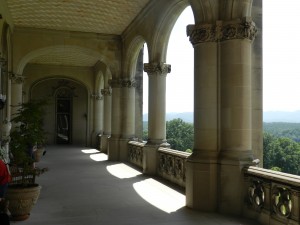
The bachelor quarters were a Gilded-Age version of today’s man caves. There were no big-screen TVs, but there were books, a billiard table, and a gun room with plenty of hunting trophies on the walls. More importantly, this was a place where men could enjoy some of the vices, such as brandy and cigars, forbidden to them in the more polite spaces. Perhaps they were also allowed there to indulge in the good-natured derisive banter typical of men in groups. Hopefully, their upper-class upbringing didn’t preclude such pleasures.
The one drawback of the tour, and also of life at the house in Mr. Vanderbilt’s day, was the absence of air conditioning. There were plenty of fans going to keep air circulating, but it still felt oppressive at times as we went through the rooms. Consequently, it was a relief despite the visual pleasures of the tour to finish and return to our car and the modern world of refrigerated air.
Incidentally, despite Biltmore’s association with the Vanderbilt family and fortune, the estate is no longer owned by people named Vanderbilt. Mr. Vanderbilt died in 1914 at the young age of 51 from complications following an appendectomy, leaving only one surviving child, a daughter. She married into the Cecils, a titled family that has provided members of the British cabinet since the days of the first Queen Elizabeth. In those days, even a Vanderbilt heiress presumably was bound by convention to take her husband’s name, so now the primary owners and top corporate officers of the Biltmore Estate are Cecils. It doesn’t seem right that it should be this way, but nothing is forever in this world—even for Vanderbilts.
